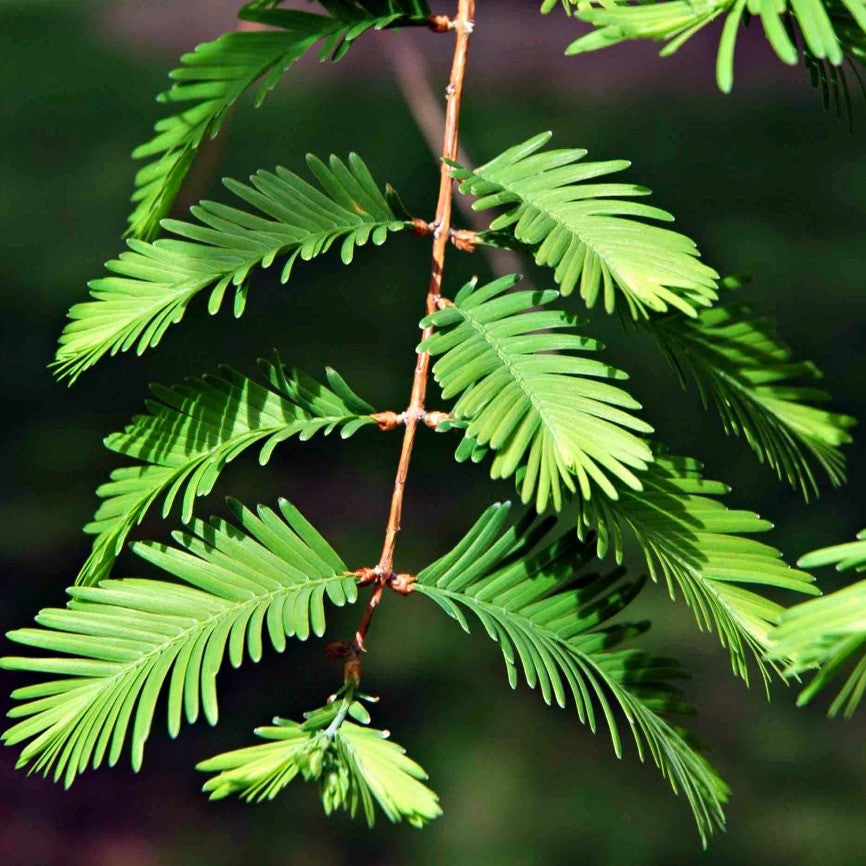
Tea made from the bark cured people who were close to death. They built shrines beneath them where they left offerings. The villagers who lived near the trees called them shui-shan (水杉, meaning ‘water fir’) and had long revered them as gods. When botanist Wang Zhan, dodging civil war and foreign invasion, discovered Metasequoia trees growing in a remote valley of China in 1943, it was like someone had found a living dinosaur. Then, miraculously, it was found to still be alive.

When it was described by a Japanese paleontologist in 1941, the extinct tree was given the name ‘ Metasequoia’, meaning ‘Redwood-like tree.’ It then disappeared from the fossil record completely around 20 million years ago. Once the earth began to cool, it migrated south over the Beringia Corridor into East Asia. dropping its foliage seasonally) during this period as a response to the Arctic circle’s light cycles, in which winter brings 3 months of darkness. Some scientists believe that the species became deciduous (i.e. During the Paleocene-Eocene Thermal Maximum event 52 million years ago (in which a massive spike in CO2 levels caused global temperatures to rise by 5 ☌ almost overnight), dawn redwood was forced to migrate north to the Arctic circle where the climate was temperate, if not subtropical, and became a major part of the Arctic deciduous forest. The earliest fossils are older than 150 million years, and toward the end of the Cretaceous it had become one of the most dominant trees in northern forests, particularly across what would later become North America. Keep very well watered when first planted.Dawn redwood ( Metasequoia glyptostroboides) is a truly unique tree - often called a "living fossil" due to its incredible age. Allowing soil to accumulate round the base of a tree can be fatal. This will help avoid the chance of cross contamination of disease.Īs with all woody plants, plant high, exposing as much of the taper at the base of the trunk as possible. When clipping several plants with the same tool, have a bucket containing a 5% bleach solution and swish your blades around for 30 seconds between plants to sterilise them. It’s not known to grow in standing water and doesn’t seem to produce the famous ‘knees’ found on the Swamp Cypress but in stature it’s more like the mighty Coast Redwood ( Sequoia sempervirens)Ī translation : Meta sequoia means a bit like a Sequoia and glyptostrob-oides means a bit like (the -oides ending always means ‘like’) a Glypostrobus, the Chinese Swamp Cypress. It’s like a bigger, more slender version of the related Swamp Cypress ( Taxodium distichum) being deciduous with similar delicate foliage. As they’ve only been in cultivation in Britain for 70 years, who knows when it’ll stop? It’s a fine specimen in rude health but being on its own it looks lonely and I feel bad. It grew like a rocket so now – in 2020 – it must be 60ft tall. I planted it in 1985 because I wanted to see what it would do. Having said that, I have one in my garden.

They love each other’s company and they look so bold and wonderful when grown together – so try a grove or two. If you want a collection of Latin names in your garden (an arboretum?) than plant one on its own but from a design point of view this (in my modest opinion) accomplishes nothing. Like all of these tall conical conifers, their use needs some thought. I’ve linked the Wollemi to another part of our website but not the Coelacanth as we don’t sell them. The Dawn Redwood has become one of the most famous of these prehistoric species that came back to life along with the Wollemi Pine ( Wollemia nobilis) and the Coelacanth. I say ‘not surprisingly’ because any species (be it plant or animal) that’s remained unchanged for many millions of years will have evolved many ways of dealing with both hell and high water. It was introduced into cultivation in 1949 and – not surprisingly – has proved entirely reliable, disease free, vigorous and robust. And then – in 1941 – it was discovered growing happily in Sichuan in Western China. It’s extraordinary to think that there was fossil evidence of this tree’s existence from the Mesozoic and – because no one had found it – an assumption that it had been extinct since then. One of a rare breed of plant that the palaeontologists knew existed before the botanists. Metasequoia glyptostroboides (Dawn Redwood)


 0 kommentar(er)
0 kommentar(er)
